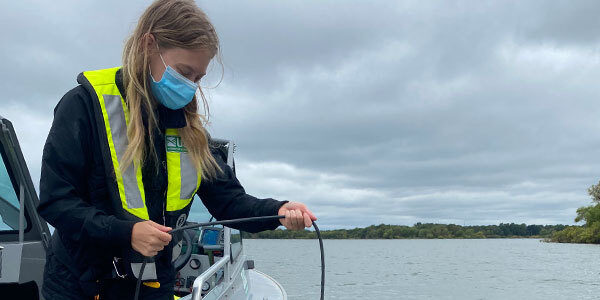Conductive temperature, pH, concentrations of calcium and dissolved oxygen, and other physiochemical water properties are critical for zebra mussel survival, growth, and reproduction. Collection of water-quality data assists in risk assessments for zebra mussel infestation and studies of population dynamics. Together with the zebra mussel occurrence and distribution data, the water-quality data we collect enhances our understanding of dreissenid mussel ecology and potential range in temperate, low-latitude waters.
We use automated water-quality data sondes to measure and record water temperature, dissolved oxygen, specific conductance, and pH at five-foot depth intervals from the lowest depth to the surface, providing a spatial profile of water-quality conditions. Discrete water-quality samples are collected at a subset of sites and are kept below 5 degrees Celsius until shipped to the USGS National Water Quality Laboratory in Denver, Colo. The water-quality samples are analyzed for nutrients, common ions (such as calcium), and alkalinity. Water-quality data has been averaged from all sites at each study area and are available by choosing a study area from the locations tab on the navigation bar.

In addition to data from automated water-quality sondes, discrete water-quality samples are collected using standard USGS protocols at a minimum of two discrete points in the water column at selected sites. Discrete water-quality samples are analyzed for alkalinity, major ions (calcium, chloride, fluoride, magnesium, potassium, silica, sodium, and sulfate) and nutrients (nitrogen, nitrites, nitrates, phosphorus, and orthophosphate).

Water-quality sondes are used to measure basic water-quality characteristics (water temperature, dissolved oxygen, pH, specific conductivity) from rivers and creeks, usually by lowering the sonde down to the water from a bridge. All water-quality samples are stored in the USGS National Water Information System (NWIS).